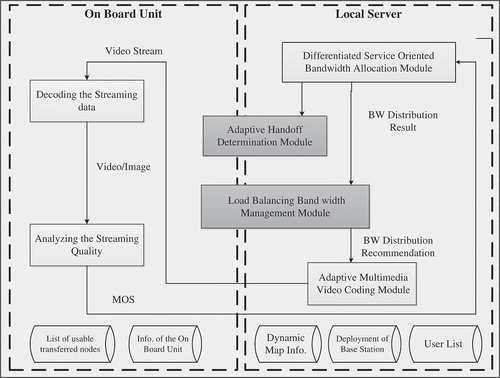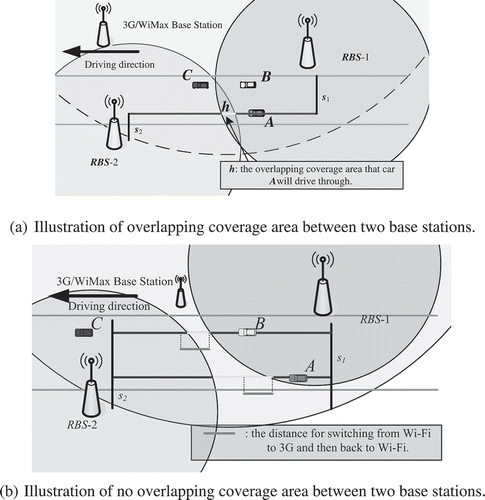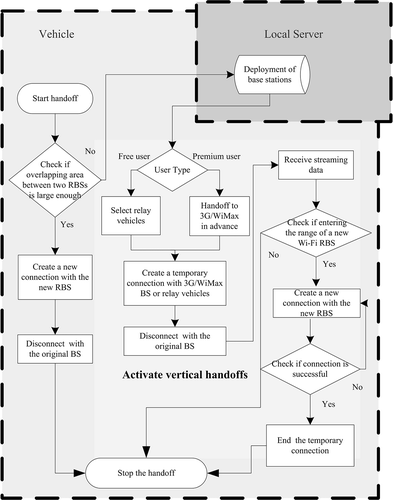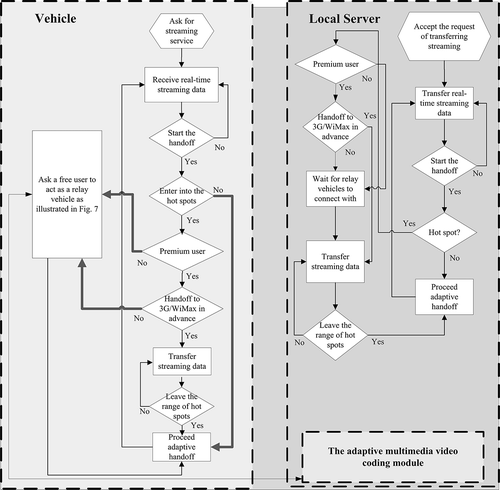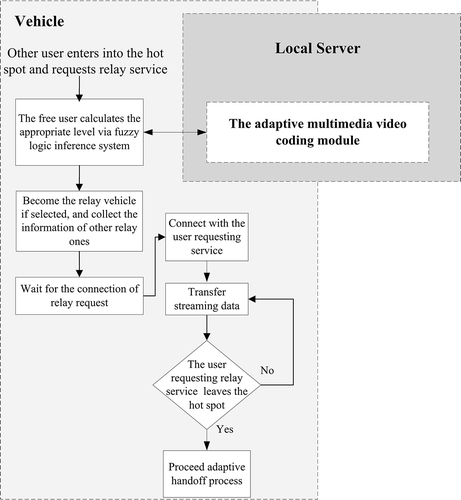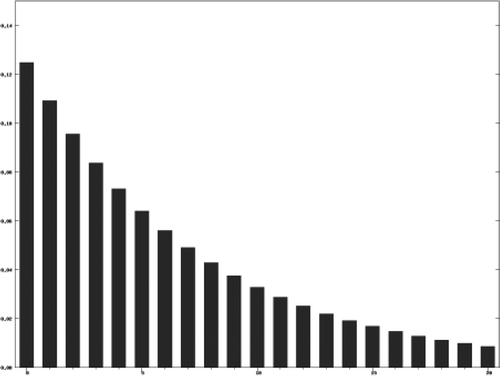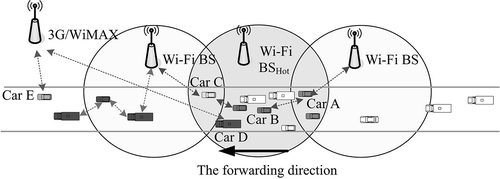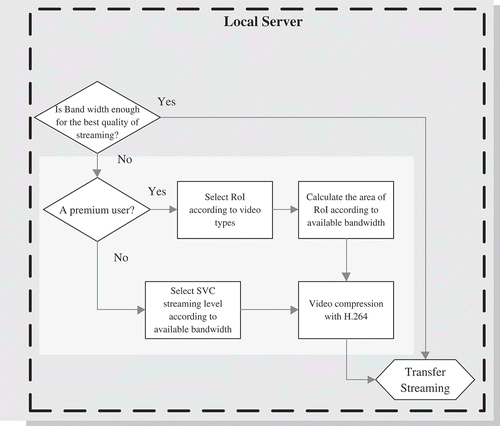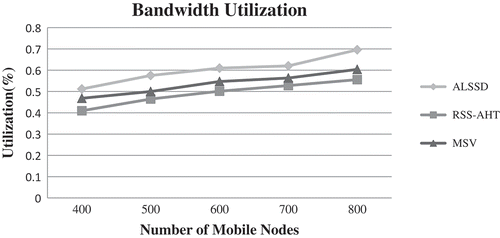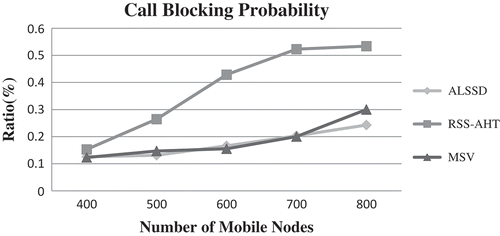Abstract
With the popularity of vehicular networks, how to maintain high quality of the seamless live streaming service is a great challenge. In this work, an adaptive seamless live streaming dissemination system for heterogeneous vehicular networks to tackle this challenging issue is presented. First, differential service is presented in this work to ensure that paid users can satisfy the live steaming service. Based on users’ service-level agreement, an adaptive bandwidth allocation policy is proposed in this work to attain seamless handoff. In addition, because vehicles enter into the areas of hotspots, we also present a mechanism not only to prevent the insufficient bandwidth in advance, but also to make sure the paid users have higher priority than free users to obtain the seamless streaming service. When an unavoidable congestion occurs, we compress the streaming videos with a Region of Interest approach based on the content and characters of the video in order to maintain the service quality of paid users and reduce the required bandwidth for the streaming services. A series of simulation results show that our mechanism achieves better performance in terms of bandwidth utilization, packet loss ratio, and blocking probability. The capability of self-adaption in volatile real-time vehicular environment assists in the effectiveness and practicability of our proposed approach.
INTRODUCTION
With the rapid development of mobile networks and the popularization of intelligent mobile phones, surfing the Internet via a mobile device to access wireless network service is getting more and more popular in our daily life, and the increase of multimedia applications results in higher data transmission traffic. The communication technologies, thus, keep evolving to provide rapid data transmission capacity to realize the requirement of transmitting streaming video and to expand the services and applications of wireless communication (Banerjee, Kramer, and Mukherjee Citation2006).
Recently, different radio access technologies (RATs), such as WiMax, 3G, and Wi-Fi, coexist in vehicular heterogeneous networks. Each RAT has to establish its base station (BS), which owns its transmission range. As a result, a handoff may occur while moving from one BS to another. However, if the remaining bandwidth of the destination BS is not available, a handoff failure will occur, unavoidably.
Nowadays, the popularity of multimedia streaming services across the technologies of wireless networks provides major challenges in the management of network bandwidth in vehicular networks. In terms of the on-board unit (OBU), a middleware with communication modules is utilized to be embedded in a vehicular entertainment system, which integrates Microsoft Silverlight streaming technique and Microsoft Expression Encoder to make a Smooth Streaming effect and provide users an optimal viewing experience. However, this solution can deal with only the on-demand streaming video, and this smooth streaming technique should be modified extensively to fit the volatile vehicular network environments.
In this work, an adaptive, real-time, seamless streaming dissemination system for heterogeneous vehicular networks to tackle the aforementioned challenges is proposed. The goals of this work are to deal with the issues of fairness of bandwidth allocation and to maintain the viewing quality of real-time streaming data seamlessly. Also, several modules, including the differentiated service-oriented bandwidth allocation module, the adaptive handoff-prediction module, the load-balancing bandwidth management module, and the adaptive multimedia video coding module were utilized to improve the adaptability of different service level agreements (SLAs) of users to achieve the best transmission efficiency. A series of experiments were performed, and the experimental results exhibit the feasibility and practicality of our proposed work.
The remainder of this article is organized as follows. “Related Work” gives a brief overview of the literature. The section following that presents the proposed adaptive, real-time, multimedia streaming dissemination scheme for heterogeneous vehicular networks. “Simulation Results” discusses the outcome of our findings, and “Conclusion” is made in the final section.
RELATED WORK
How to make users with mobile devices enjoy real-time video service in heterogeneous vehicular networks is an important issue. To achieve a fine real-time service, a quick handoff procedure is necessary to decrease the ratio of packet loss in heterogeneous vehicular networks, and the service level agreement (SLA) was presented to solve aforementioned problems. The SLA is a signed contract between a service provider and a customer to ensure the content of service. Bruneo, Scarpa, and Puliafito (Citation2010) introduced two different SLA typologies to provide a business-oriented performance analysis and emphasize how it may influence the expected profit of the service provider. Fawaz et al. (Citation2004) discussed several possible provisioning methods in an optical network to activate a service via the SLA agreement applied to the optical domain (O-SLA), which was proposed for the purpose of satisfying both the requirements of clients and operators and providing guidance with regard to service negotiations and agreements. Skene, Raimondi, and Emmerich (Citation2010) developed a language support for SLA and pointed out that SLA might contribute to mitigating outsourcing risks concerning electronic services.
Different radio access technologies (RATs) have their own advantages and limitations, and therefore, when a user accessing Internet services drives in heterogeneous networks, a handoff might occur related to the movement itself or the change of the source of the signal. Ben Ali and Pierre (Citation2009) estimate the influence of both soft vertical handoff (SVHO) and WLAN mobility on call-blocking and dropping probabilities to prevent the voice quality of service (QoS) from degrading severely in loosely coupled networks, and this work showed that a resource-efficient SVHO can give better performance in low mobility areas. Wang, Xie, and Hu (Citation2009) studied the performance of the call admission control for a code division multiple access (CDMA)-based cellular system and addressed the soft handoff procedure and the cellular geometry in CDMA systems under certain assumptions; they presented an analytical model for this architecture based on continuous time Markov Chain. The recursive analysis used for calculating the decision on soft or hard handoff will be chosen as the comparison in our work. Reaz et al. (Citation2010) provide an efficient handoff scheme for multiclass networks, and this scheme performed soft handoff for interclass and intraclass mobility in a wireless network and can perform low-loss location management. Hence, we will take this scheme into consideration as our location management method in order to decrease the ratio of packet loss and the delay of handoff.
In the vehicular network environment, the signal strength on a wireless network might influence the quality of streaming video due to the weather conditions or the driving status. The number of users within the same area would also be considered as a factor to decide the bandwidth allocation strategies. Users are divided into two types, including free users and premium users. Although facing the situation of bandwidth shortage, we expect to maintain premium users’ quality of experience (QoE). However, when most parts of the bandwidth are allocated for premium users, the quality of the video is still unsatisfying, and an approach called region of interest (ROI) is utilized in this work to keep the QoE for premium users (Gulliver and Ghinea Citation2009). ROI is a subset of an image that a user is mostly interested in, and the rest parts are the unnoticeable areas. In addition, an approach, region of interest-based adaptive scheme (ROIAS), was proposed by Ciubotaru, Muntean, and Ghinea (Citation2009) to differently adjust the regions within each frame of the streamed multimedia content according to each user’s interest. Liu, Li, and Soh (Citation2008) presented an ROI-based H.264/AVC system for real-time conversational video communication; this method can allocate more resources, such as bits and computational power, and can adaptively adjust several coding parameters, including QP, macroblock candidate modes, the number of reference frames, motion estimation (ME) accuracy, and ME search range. Chi, Yeh, and Chen (Citation2009) presented a robust ROI determination approach with regard to user attention models via visual rhythm analysis for analyzing video content to fasten the determination of ROI. In our work, we try to keep the fine quality of the ROI and degrade the resolution of the rest parts. Hence, the total bandwidth requirement will be dramatically decreased, but the QoE will be maintained simultaneously. as well.
AN ADAPTIVE REAL-TIME MULTIMEDIA STREAMING DISSEMINATION SYSTEM FOR VEHICULAR NETWORKS
The scenario of the proposed multimedia streaming dissemination system is illustrated in . The road map is first divided into several parts, and we utilize the distributed local server allocated at each part of the road map to collect video and streaming data via Internet providers, such as P2P real-time multimedia providers or real-time streaming servers. Before the real-time streaming data transfers to users, it will be sent to local servers. The local server will be responsible for bandwidth allocation and image adjustment. Also, the server will allocate resources according to an individual user’s SLA and will increase/decrease the quality of image to maintain not only image stability without interruption, but also the user’s QoS based on the situation of the current Internet environment. The user can also choose an appropriate approach to decide the manner of connection or the time of handoff so that congestion can be effectively avoided.
The proposed adaptive live multimedia streaming dissemination system for vehicular networks is shown in . To maintain the reliable quality of the video for the viewers, four modules in the local server are allocated to ensure the fairness of bandwidth allocation and seamless handoff for real-time communication. First, when the local server receives the streaming data from the real-time streaming providers, the differentiated service-oriented bandwidth allocation module will allocate bandwidth according to each individual user’s SLA and the mean opinion score (MOS) sent by users. If the handoff occurs while the streaming data are transferred to users, the adaptive handoff determination module can calculate the appropriate handoff time between different network types according to the overlapping range of base stations, driving velocity, and so on. Notably, the load-balancing bandwidth management module is employed to solve the problem of bandwidth shortage in order to avoid congestion. Finally, the adaptive multimedia video coding module is used to adjust the image quality based on the amount of assigned bandwidth. When an on-board unit receives the streaming data, it will be encoded, and the user will reply with the MOS to the differentiated service-oriented bandwidth allocation module installed in the local server to determine if the image needs to be adjusted. The detail function of each module will be addressed in the following sections.
The Differentiated Service-Oriented Bandwidth Allocation Module
In the mobile network environment, the bandwidth of the Internet is not stable because of the cost of the network types, such as 3G and Wi-Fi. How to provide video streaming service and allocate the limited resources fairly to each user is a challenging task. In this work, we classify users into two types, including a premium user and a free user, based on the SLA signed by the users. A free user does not need to pay for the use of bandwidth. In the case of shortage of the bandwidth, the quality of the streaming data for the free user will be degraded in order to release more bandwidth to meet the minimum bandwidth requirements for the premium user, who has higher priority. Meanwhile, the free users may become a relay node in a wireless network to provide packet forwarding services without any compensation. A premium user has higher priory for bandwidth allocation and might pay extra cost to satisfy the lowest quality of the video guarantee or required roaming service.
The differentiated service-oriented bandwidth allocation module proposed in this study provides the differentiated real-time video streaming service based on the MOS derived from the quality of streaming that the user receives. Notably, MOS is an evaluation of an index, which is calculated and analyzed by the peak signal to noise ratio (PSNR) after each user receives his/her video streaming service (Brooks and Hestnes Citation2010). lists the mappings from PSNR to MOS.
TABLE 1 The Mapping Table from PSNR to MOS
After a user receives the real-time video streaming file, the PSNR decoded by the decoding module is transformed into the corresponding MOS, and the parameter can thus be provided to servers as the reference in distributing bandwidth to ensure that each user can receive bandwidth fairly.
Next, the local servers will adjust the strategy bandwidth allocation based on all users’ MOS, the current types of wireless network, and the allocated bandwidth. The detailed description of the strategy can be separate into four parts. First, although the MOS shows “good” video quality, if the allocated bandwidth is larger than the one actually used, it decreases the allocated bandwidth. Second, if the MOS does not achieve “good” quality, it adjusts the bandwidth allocation based on the SLAs of the users. Third, if the users are premium users, the bandwidth will be adjusted into the upper bound of SLA directly. At the final step, the bandwidth is adjusted individually if the users are free users. As a result, this module updates the latest bandwidth allocation table and transfers it to the load-balancing bandwidth management module as the reference to determine if further bandwidth allocation is needed.
The Adaptive Handoff Determination Module
Because the traditional handoff will inevitably lead to the interruption of transferring real-time streaming data, this work uses the concept of soft handoff to avoid the aforementioned problem. A user will estimate if she/he has enough time complete the handoff before crossing the overlapping coverage area of two roadside base stations. Take (a) as an example. Cars A, B, and C are currently moving from right to left. The overlapping coverage area of roadside base stations RBS-1 and RBS-2 is large enough for car A to handoff; whereas that for car B is not. This study will request car C to act as a relay node for car B, if necessary.
We first need to determine if the overlapping coverage area of two roadside base stations is enough for users to handoff when a user intends to move from the coverage of one station to that of the neighboring roadside base station in order to avoid streaming data interruption. As shown in (a), two solid circles represent the communication range of roadside base stations, RBS-1 and RBS-2, and h denotes the length of the pathway for car A to handoff from the coverage of RBS-1 to that of RBS-2. After knowing the length of h and the velocity of car A, we can derive how much time we have for a successful handoff.
Two types of situations are considered in order to obtain the path length of the overlapping coverage area of two neighboring roadside base stations, h. One is for the two roadside base stations residing on the same side of the pathway, and the other is for those residing on the opposite side of the pathway. The path length of the overlapping coverage area for the first case can be obtained by
The path length of the overlapping coverage area for the latter case, which is also the example given in (a), can be expressed as
As a result, the handoff time for car A can be represented as follows:
shows the complete flow of the adaptive handoff determination. In sum, a vehicle can directly handoff and connect to the next roadside base station if the overlapping coverage area of two adjacent base stations is large enough. After connecting to the neighboring base station, the vehicle will examine whether it can receive the streaming data via the neighboring roadside base station. If it cannot receive the streaming data, the vehicle will attempt to reconnect with the neighboring roadside base station and check if the streaming data can be received successfully. The vehicle will disconnect with the original roadside base station after the streaming data can be received correctly from the new connected base station.
If there is no overlapping coverage area between two roadside base stations, as shown in (b), the time for vertical handoff will be much longer. Take car B in (b) as an example. Car B needs to handoff from Wi-Fi to 3/WiMax and then back to Wi-Fi, and the time spent for two consecutive vertical handoffs is longer than that taken for moving from the coverage boundary of the first Wi-Fi base station, RBS-1, to the coverage boundary of the second Wi-Fi base station, RBS-2. Accordingly, the packet-dropping rate for the handoffs is not effectively reduced because of the overhead of two consecutive vertical handoffs. Otherwise, if the time spent for moving across the nonoverlapping area of the two Wi-Fi base stations is longer than the time spent for two vertical handoffs, as in the example of car A illustrated in (b), the vertical handoffs will be adopted to prevent the real-time streaming data from dropping while moving across the coverage boundaries of two Wi-Fi base stations. Notably, different services are provided depending on users’ SLAs. If the user is a premium user, the vehicle can handoff to the 3/WiMax base station while the vehicle moves out of the communication ranges of the Wi-Fi roadside base stations. However, a free user can only request other neighboring vehicles, such as car C in , to act as the relay nodes for temporally forwarding packets for her/him.
The Load Balancing Bandwidth Management Module
The traffic congestion problem caused by the overutilization of certain roadside base stations, which are often referred as hot spots, is the next issue we need to address, apart from handoff problems. As shown in , a load-balancing bandwidth management module is proposed to tackle the bandwidth scarcity problem occurring at hot spots.
First, users request the service of transferring streaming data. They will start receiving real-time streaming service and then report the streaming quality and the driving information back to the server after their request is granted. The reported driving information includes the current allocated bandwidth, the service that the users are using, the driving speed, and the current location, etc.
The server will notify users of possible occurrence of handoffs or existence of hot spots. Users will keep receiving the streaming data and reporting the quality and the driving information if they determine a handoff is not required at this moment. Otherwise, the users examine if they will access the possible hot spots. They will proceed with the handoff process if no hot spots are nearby. Otherwise, the system will make different decisions based on users’ SLAs if the users are approaching hot spots.
The premium users will proceed with the handover process and will keep receiving the streaming data as usual, if the roadside base station they connect with can provide enough bandwidth. Otherwise, the premium users can handoff to the 3G/WiMax base station while they reside within the coverage range of hot spots. In the case of free users, if the roadside base stations have unused bandwidth, the free users can keep using the available bandwidth of the roadside base stations. However, if the premium users access the hot spots at this moment, the free users have to interrupt their connection and release the bandwidth back to the congested base stations. Also, the system also reports the video quality back to the adaptive multimedia video coding module in the local server to decide the current video quality that adapts to the amounts of unused bandwidth.
As shown in , if a free user close to other users is requested to act as a relay vehicle, the vehicle-to-vehicle communication also becomes an alternative approach to maintain the real-time streaming transmission. Notably, a fuzzy logic inference system, as shown in , is adopted to determine the appropriateness of a free user to act as a relay node. The inputs to the fuzzy logic inference system include the strength of the signal, the available bandwidth, and the time to access the hot spots.
The vehicle that is most suitable to act as the relay node is then selected to forward streaming data to other users after they enter the hot spots. This kind of relay service attempts to make other users receive the real-time streaming service even when they enter the hot spots. The relay vehicle is disconnected from the users that receive the relay service after they leave the hot spots or another vehicle is determined to be more suitable to act as the relay node for them.
To determine if a roadside base station is a hot spot at a specific time, we need to estimate the total bandwidth required by the vehicles that are within the coverage of the roadside base station at that specific time. If the requested bandwidth for the base station exceeds some preset threshold, we can determine that the roadside base station would be a hot spot at that specific time, and then seek a suitable vehicle as the relay nodes for forward streaming data to the premium users after they enter the hot spots, if necessary.
We first predict the speed of the vehicle by using the exponential moving average (EMA),
Next, we assume that the path length on which a vehicle enters the communication range of a roadside base station is d1 and that the path length by which the vehicle will leave the communication range of the roadside base station is d2. Accordingly, we can obtain the time entering and leaving the communication range of the roadside base station as t1 and t2 as follows:
The bandwidth allocated by the roadside base station at a specific time t can be expressed by
When the bandwidth allocated by the roadside base station at a specific time t exceeds some threshold, we can believe the roadside base station would be a hot spot at time t. A free user who enters the hot spot at time t then becomes a candidate for relay vehicle to provide the transmission service for other premium users. The relay vehicle then calculates its appropriateness level for acting as a relay node via a fuzzy logic inference system as shown in , in which a fuzzy rule example shows that if the signal strength is high, the available bandwidth is medium, and the time before entering the hot spot is long, the appropriateness level for becoming the relay vehicle will be high.
The nonfuzzy output of the defuzzifier can then be expressed as the weighted average of each rule’s output after the Tsukamoto defuzzification method is applied:
Once a vehicle finds its appropriateness level is high, it will broadcast to the surrounding vehicles and wait for receiving requests of forwarding service from premium users. Notably, the relay vehicle will keep recording other available relay vehicles for forwarding service after entering the hot spots in order to ensure uninterrupted streaming service for premium users.
After investigating the traditional handoff approaches, we realize that some extra work needs to be done on the proposed load-balancing mechanism to reduce the overload of hot spots in most occasions. The approaches for lessening the overload of hot spots in these cases are separately discussed following.
Case 1: Take Car A in as an example. If the next roadside base station that the vehicles will enter is a hot spot, the system will delay the handoff process until the vehicle enters the coverage of the base station next to the hot spot in order to avoid using the bandwidth of the hot spot. Some vehicles, such as Car B in , will be used as the relay nodes for forwarding services if Car A is a premium user. However, the free users are not allowed to be connected to the hot spot and they cannot request relay service either. They will connect to the base station that is next to the hot spot after they leave the coverage range of the hot spot.
Case 2: Take Car C in as an example. No matter what service type the vehicle is, it will handoff to the base station next to the hot spot immediately after it enters the coverage of that base station, in order to alleviate the congestion of the hot spot.
Case 3: If a premium user is within the coverage of a hot spot, such as Car B in , the premium user will request the real-time streaming service from the hot spot. If there is not enough bandwidth provided, the system will select the appropriate vehicles from the boundary of two neighboring roadside base stations, i.e., Car A and Car C in , to transfer the streaming data.
Case 4: When a vehicle cannot connect to any roadside base station, it will try to connect to 3G or WiMAX instead. The reason is that it might not find any relay vehicles in the hot spots, like Car D in , or not in the coverage area of any roadside base stations, like Car E in . In the case that the vehicles cannot connect to 3G/WiMAX either, the predictive mobility and location-aware routing (PMLAR) algorithm presented by Lu and Feng (Citation2005) is adopted in this work to tackle the aforementioned problem. The PMLAR can incorporate the moving behaviors of the mobile nodes and forecast the future trajectory of the destination node. As a result, we can predict the future location of the relay vehicles and maintain the satisfied streaming service for the premium users.
In sum, the number of hot spots can be effectively reduced and the shortage of the bandwidth that deteriorates real-time streaming service for premium users can be largely avoided based on the aforementioned operations. In the case that the bandwidth allocated for the premium users cannot satisfy their SLAs, the adaptive multimedia video coding module, as described in the following section, can be used to resolve the bandwidth shortage problem.
The Adaptive Multimedia Video Coding Module
To solve the problems of congestion in a hot spot area and the limitation of the upper bound of bandwidth usage, an adaptive multimedia video coding module was used to provide satisfying service, and the flow is shown in .
First, this module determines if the bandwidth is available for providing the highest streaming QoS. If the bandwidth is not sufficient, the proposed adaptive differentiated service will be adopted to compress the video streaming based on the users’ SLAs. Three types of RoIs, as shown in , are adopted in this work for satisfying the SLA of a premium user. Next, we calculate the area of RoI for each user according to the allocated bandwidth and then maintain the image quality of RoI. The non-RoI was conducted via a video compression technique. The size of the RoI area can be calculated by using the ratio of the required bandwidth of the original streaming quality and the current allocated bandwidth. The calculation of the RoI area can be expressed by
TABLE 2 The Classification of RoIs for Real-Time Streaming of Premium User
shows the mapping of streaming quality under each condition and its required bandwidth defined in H.264. Finally, the coded streaming data will be transferred to the premium users.
TABLE 3 The Mapping of Streaming Quality and Required Bandwidth in H.264
For a free user, we adopt the standard of scalable video coding (SVC) to choose the compressed level and the frame size adaptively, according to currently free bandwidth. After the compressed level is decided, the video compression will proceed and then the coded streaming data can be transferred to free users directly. The resolution of SVC is also determined by the mappings given in .
Although it takes effort to calculate the RoI area for premium users, it decreases the transmission throughput of the streaming data without sacrificing the image quality of the area of main concern for the users. Therefore, the proposed adaptive differentiated service can not only provide different types of service according to users’ SLAs, but can also effectively distribute bandwidth on the condition of limited bandwidth to achieve the utmost benefits.
SIMULATION RESULTS
We ran a series of simulations to verify the feasibility and effectiveness of our proposed adaptive live streaming dissemination system (ALSSD) in a heterogeneous network environment. The simulation parameters are shown in . The range of the simulation area is 5000 m × 5000 m, including roads’ intersections to reflect the real situation. The moving speed of each vehicle is between 40 km/hr and 82 km/hr, and 400 free users and 100 premium users are randomly generated on the pathways. The types of the wireless networks are Wi-Fi, WiMAX, and 3G. In addition, the transmission range of Wi-Fi roadside base stations is 80 m.
TABLE 4 Simulation Parameters
Bandwidth utilization, packet loss ratio, and blocking probability are adopted as performance metrics to verify the effectiveness of our proposed work. Bandwidth utilization, also known as channel efficiency, represents the data received from adaptive streaming server related to the overall bitrate of networks. Packet loss ratio stands for the probability that packets get lost in the transmission process owing to such factors as environmental interruption and available bandwidth being not enough. Blocking probability denotes the probability that handoff is blocked because the neighboring roadside base station becomes the hot spot and cannot provide sufficient bandwidth for the handoff.
Two representatives of related researches in the literature, including received signal strength with an adaptive hysteresis threshold system (RSS-AHT; Huang, Lin, and Yang Citation2010) and multisource video streaming system (MSV; Qadri et al. Citation2010), were compared with our proposed work. RSS-AHT developed a ubiquitous video streaming platform to make users watch seamless multimedia at any time, in any place, and with any device. It takes the vertical handoff in heterogeneous networks into consideration, and makes appropriate adjustment according to the network environment and the type of computing device. MSV was constructed across an overlay network, and it utilizes the concept of multisourcing among vehicles that transfer streaming data to achieve the service of multimedia streaming.
illustrates the bandwidth utilization on the condition of different numbers of vehicles among the three algorithms. Although the increase of vehicles means that the loading of the roadside base station also increases and the available bandwidth decreases gradually, our proposed ALSSD scheme can maximize bandwidth utilization among the three schemes. Our proposed differentiated service -oriented bandwidth allocation module classifies users into two types: free users and premium users. While the number of users is increasing, the system will release the resource of free users and proceed on the prediction of hot spots to ensure that the premium users can enjoy a seamless real-time streaming. Therefore, our proposed system can effectively manage the bandwidth allocation even when the number of vehicles increases.
The comparison of the packet loss ratio is given in . Although MSV adopted the architecture of multisource to receive streaming data via P2P, it did not take the load-balancing bandwidth management into account, and congestion might occur at some specific roadside BSs. RSS-AHT took the vertical handoff in the heterogeneous network into consideration, but it did not prevent the situation of hot spots resulting from congestion. Our proposed adaptive handoff determination module can predict the hot spots area and calculate the appropriateness level of relay vehicles applied with a fuzzy logic inference system to ensure uninterrupted streaming service for premium users. Therefore, the propose ALSSD has less packet loss ratio than RSS-AHT and MSV.
The comparison of the blocking probability is given in . Our proposed adaptive handoff determination module can effectively proceed with the handoff process in order to avoid the next roadside base station becoming a hot spot, and therefore, premium users can still enjoy watching high quality streaming. RSS-AHT cannot avoid the congestion problem and results in a serious blocking probability due to the architecture design of the scheme. In addition, MSV achieves similar performance with our proposed method because it can obtain streaming data via other vehicles. However, if more connections occur, blocking probability becomes a little serious in MSV. Our proposed load balancing bandwidth management module can dramatically decrease the probability by effectively predicting the locations of the hot spot areas. Meanwhile, the proposed adaptive handoff determination module can lessen the overload of hot spots and reduce the handoff failures accordingly.
CONCLUSION
With the rapid development of wireless technologies, the need for real-time streaming service on mobile devices is increasing. However, there are still some difficulties to be overcome, such as unavoidable congestion, fairness of bandwidth allocation, and volatile network environment. In this work, an adaptive seamless live streaming dissemination system for vehicular networks is proposed to solve the these problems. Four modules are designed to deal with different kinds of network environment to ensure the fairness of bandwidth allocation and seamless handoff for real-time communication. First, the differentiated service-oriented bandwidth allocation module is presented in this work to ensure that different types of users—free users or premium users—can get different service and maintain the high quality of playing streaming for premium users. If the handoff occurs while the streaming data are transferred to users, the adaptive handoff determination module can calculate the appropriate handoff time among different network types. In addition, because vehicles enter into the areas of hotspots, we also present the load-balancing bandwidth management module not only to prevent the insufficient bandwidth in advance, but also to make sure the premium users have higher priority than free users. Finally, the adaptive multimedia video coding module is used to adjust the image quality based on the amount of assigned bandwidth. Comparing our simulation model with the two latest frameworks, RSS-AHT and MSV, the simulation results show that our mechanism achieves better performance in terms of bandwidth utilization, packet loss ratio, and blocking probability. The capability of self-adaption in a volatile real-time vehicular environment assists in the effectiveness and practicability of our proposed approach.
FUNDING
The authors would like to thank the National Science Council of the Republic of China, Taiwan for financially supporting this research under Contract No. NSC 102-2511-S-259-010-MY3
Additional information
Funding
REFERENCES
- Banerjee, A., G. Kramer, and B. Mukherjee. 2006. Fair sharing using dual service-level agreements to achieve open access in a passive optical network. IEEE Journal on Selected Areas in Communications 24(8):32–44.
- Ben Ali, R., and S. Pierre. 2009. On the impact of mobility and soft vertical handoff on voice admission control in loosely coupled 3G/WLAN networks. IEEE Communications Letters 13(5):303–05. doi:10.1109/LCOMM.2009.090121.
- Brooks, P., and B. Hestnes. 2010. User measures of quality of experience: Why being objective and quantitative is important. IEEE Network 24(2):8–13. doi:10.1109/MNET.2010.5430138.
- Bruneo, D., M. Scarpa, and A. Puliafito. 2010. Performance evaluation of gLite grids through GSPNs. IEEE Transactions on Parallel and Distributed Systems 21(11):1611–25. doi:10.1109/TPDS.2010.35.
- Chi, M.-C., C.-H. Yeh, and M.-J. Chen. 2009. Robust region-of-interest determination based on user attention model through visual rhythm analysis. IEEE Transactions on Circuits and Systems for Video Technology 19(7):1025–38. doi:10.1109/TCSVT.2009.2022822.
- Ciubotaru, B., G.-M. Muntean, and G. Ghinea. 2009. Objective assessment of region of interest-aware adaptive multimedia streaming quality. IEEE Transactions on Broadcasting 55(2):202–12. doi:10.1109/TBC.2009.2020448.
- Fawaz, W., B. Daheb, O. Audouin, M. Du-Pond, and G. Pujolle. 2004. Service level agreement and provisioning in optical networks. IEEE Communications Magazine 42(1):36–43. doi:10.1109/MCOM.2004.1262160.
- Gulliver, S. R., and G. Ghinea. 2009. A perceptual comparison of empirical and predictive region-of-interest video. IEEE Transactions on Systems, Man and Cybernetics, Part A: Systems and Humans 39(4):744–53. doi:10.1109/TSMCA.2009.2019893.
- Huang, C.-M., C.-W. Lin, and C.-C. Yang. 2010. Mobility management for video streaming on heterogeneous networks. IEEE Multimedia 17(1):35. doi:10.1109/MMUL.2010.17.
- Liu, Y., Z. G. Li, and Y. C. Soh. 2008. Region-of-interest based resource allocation for conversational video communication of H.264/AVC. IEEE Transactions on Circuits and Systems for Video Technology 18(1):134–39. doi:10.1109/TCSVT.2007.913754.
- Lu, T. E., and K. T. Feng. 2005. “Predictive Mobility and location-aware routing protocol in mobile ad hoc networks.” Paper presented at IEEE Global Telecommunications Conference, St. Louis, Missouri, November 28–December 2, 2005.
- Qadri, N. N., M. Fleury, M. Altaf, and M. Ghanbari. 2010. Multi-source video streaming in a wireless vehicular ad hoc network. IET Communications 4(11):1300–11.
- Reaz, A., S. Fu, S. Ferdousi, and M. Atiquzzaman. 2010. mSIGMA: An efficient handoff scheme for multiclass networks. IEEE Systems Journal 4(2):210–20. doi:10.1109/JSYST.2010.2047295.
- Skene, J., F. Raimondi, and W. Emmerich. 2010. Service-level agreements for electronic services. IEEE Transactions on Software Engineering 36(2):288–304. doi:10.1109/TSE.2009.55.
- Wang, X., S. Xie, and X. Hu. 2009. Recursive analysis for soft handoff schemes in CDMA cellular systems. IEEE Transactions on Wireless Communications 8(3):1499–507. doi:10.1109/TWC.2009.080392.


